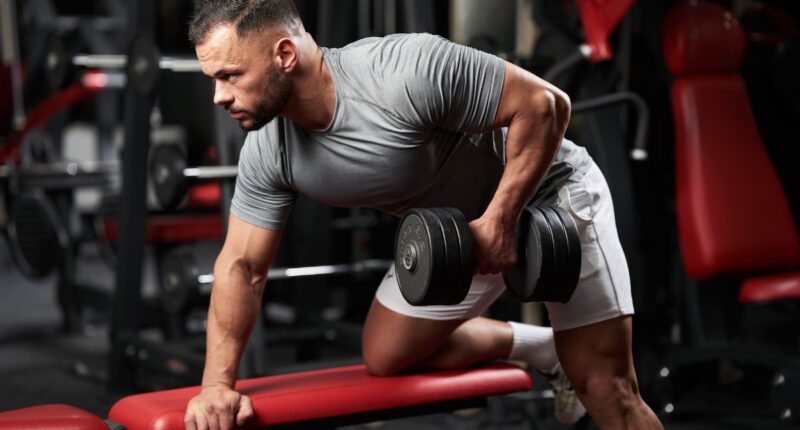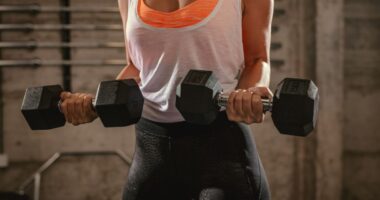The humble row exercise is an excellent choice if you want to improve your upper body strength and tone your back. This exercise targets the muscles in your upper back, and shoulders and can be performed with various equipment, making it a versatile addition to your workout routine. This article will provide a complete guide to the humble row exercise, including proper form, variations, benefits, and common mistakes to avoid.
What Muscles do Humble Rows Work?
The humble row is an excellent exercise for developing the upper back muscles. This exercise primarily targets the rhomboids, trapezius, latissimus dorsi (lats), and rear (posterior) deltoid muscles.
Rhomboids
The rhomboids are located in the upper back, between the shoulder blades. These muscles are responsible for pulling the shoulder blades toward the spine and play a vital role in maintaining good posture. During the exercise, the rhomboids are activated as you lift the dumbbells toward your ribcage, and they work to squeeze the shoulder blades together.
Trapezius
The trapezius is a large, diamond-shaped muscle that covers most of the upper back and neck. Fibers are divided into upper, middle, and lower fibers. During the humble row exercise, the middle fibres of the trapezius are primarily engaged. These fibers retract the scapulae (shoulder blades) and rotate them upwards.
Lats
The latissimus dorsi muscles are large, fan-shaped muscles covering the torso’s back and sides. They are responsible for pulling the arms down and back and play a vital role in various upper body movements such as pull-ups and rowing exercises. During the humble row exercise, the lats are engaged as you lift the dumbbells toward your ribcage, and they work to retract and depress the scapulae.
Rear (posterior) Deltoids
The rear (posterior) deltoid muscle is one of the muscles worked during the humble row exercise with chest support. Shoulder movements such as abduction, flexion, extension, and rotation are performed by deltoids, a group of muscles located in the shoulder region. The rear deltoid muscle is engaged as you lift the dumbbells toward your ribcage, and it works to extend the shoulder joint.
Benefits of Humble Row Exercise
The humble row provides numerous benefits for the upper body. Here are some of the key benefits of the exercise:
Builds Upper Back Strength
The humble row is an excellent exercise for building upper back strength. It primarily targets the rhomboids, trapezius, and latissimus dorsi muscles, essential for a strong, stable, healthy upper back.
Improves Posture
By strengthening the upper back muscles that support good posture, the exercise can help improve posture. This exercise can also help correct postural imbalances caused by spending long hours sitting or standing in a hunched-over position.
Increases Shoulder Stability
The exercise requires stability in the shoulder joint, which can help increase shoulder stability and reduce the risk of shoulder injuries.
Enhances Functional Fitness
It is a functional exercise that mimics the pulling motion commonly used in daily activities such as lifting and carrying objects. By performing this exercise, you can enhance your functional fitness and improve your ability to perform everyday tasks.
Provides Variation
The humble row exercise is a variation of the traditional dumbbell row exercise. By adding chest support, this exercise isolates and engages the upper back muscles more effectively, providing a new challenge to your workout routine.
Modifies for Different Fitness Levels
Depending on your fitness level, you can modify the humble row exercise. You can adjust the weight of the dumbbells or the angle of the bench to make the exercise more or less challenging.
How to do the Humble Row Exercise?
The humble row exercise is a variation of the traditional dumbbell row exercise but with added chest support to isolate and engage the upper back muscles more effectively.
To perform the exercise, you will need an incline bench and dumbbells. Here are the steps to follow:
- Ensure that an incline bench is set at a 30° – 45° angle, and you begin exercising.
- Lie face down on the incline bench with your chest supported and your feet firmly on the ground.
- Pick up the dumbbells with an overhand grip and let them hang at arm’s length toward the floor.
- Keep your elbows wide out of your body, and pull the dumbbells towards your ribcage, squeezing your shoulder blades together as you lift.
- At the top of the movement, pause for a second, then slowly lower the dumbbells.
- You may repeat this exercise for as many repetitions as you like.
Proper Form for Humble Row Exercise
We can distinguish between a humble row and a chest-assisted incline row by the distance our elbows extend out from our torso’s sides. Having our elbows pointing out to the side, similar to the wide-grip seated rows, makes the exercise more effective in engaging the rear delts and traps. In this way, the lats are activated less, which is the key difference between this movement and others.
Ensure that your elbows are at least 45 degrees out to the sides of your body. There is no restriction to how far you can go, but choose an angle that will activate the most rear delts and traps for you.
Humble Rows vs. Chest-Supported Dumbbell Rows
Two key differences between a humble row and a chest-supported dumbbell Row. Firstly, both incline rowing and humble rowing target the same muscles, but humble rowing is much more effective when targeting the upper and middle back.
Another difference is the hand and elbow position, which will affect which muscles are activated during the exercise.
In a Dumbbell Row, the elbows are pushed down in a sweeping motion with the hands in a neutral position, which focuses on the lats in the upper back and chest area.
Humble rows are performed with the hands in an overhand grip (pronated) and the elbows coming out at a 45 – 90 degree angle so that the upper and middle back muscles are targeted in this exercise.
Tips to Get the Best Results from Humble Row Exercise
The humble row is challenging and can provide significant benefits for the upper back muscles. Here are some tips to help you get the best results from the humble row exercise:
Use Proper Form
Proper form is essential for getting the best results. Throughout the movement, stay engaged in your core, keep your back straight, and squeeze your shoulder blades together. Use your upper back muscles to lift the weights towards your ribcage instead of using momentum.
Start with Lighter Weights
Starting with lighter weights is recommended if you’re new to the humble row exercise. As you become more comfortable with the exercise, gradually increase the weight to challenge your muscles.
Focus on Mind-Muscle Connection
Your upper back muscles will be more effectively engaged if you focus on the mind-muscle connection. Visualize your muscles working as you lift the weights towards your ribcage, and concentrate on squeezing your shoulder blades together at the top of the movement.
Breathe Properly
Proper breathing is crucial for getting the best results. Inhale as you lower the weights toward the ground and exhale as you lift the weights toward your ribcage.
Incorporate Variety
Incorporating variety into your humble row exercise can help prevent boredom and stimulate muscle growth. You can vary the weight, the angle of the bench, or the grip to target different areas of the upper back muscles.
Allow for Proper Recovery
Allow proper recovery time between workouts to avoid overtraining your upper back muscles. It is crucial for muscle growth and injury prevention to get adequate rest and recovery.
Common Mistakes When Doing the Humble Row
It is a complex movement that requires proper form and technique to be effective. Here are some common mistakes to avoid when doing the humble row exercise:
Using too Much Weight
It is possible to become injured if you carry too much weight. Increase your weight as you become comfortable with the movement, starting with lighter weights.
Arching Your Back
You may be at risk of injury if you arch your back during the exercise. Throughout the movement, keep your back straight and your core engaged.
Rounding Your Shoulders
Rounding your shoulders during the exercise can take the focus away from your upper back muscles and place stress on your neck and shoulders. Keep your shoulders back and down throughout the movement.
Lifting with Your Arms
Lifting the weights with your arms rather than using your upper back muscles can limit the effectiveness of the exercise. By squeezing your shoulder blades together, you will be able to lift the weights toward your ribcage using the muscles in your upper back.
Neglecting the Chest Support
Neglecting the chest support during the humble row exercise can compromise your form and reduce the effectiveness of the exercise. Use the chest support to stabilize your upper body and maintain proper form throughout the movement.
Moving too Quickly
Moving too quickly during the exercise can compromise your form and reduce the effectiveness of the exercise. Focus on slow and controlled movements, and avoid using momentum to lift the weights.
By avoiding these common mistakes, you can perform the humble row exercise with chest support safely and effectively and get the most out of this challenging exercise.
Alternatives & Variations To Humble Rows
If you’re looking for alternatives or variations to the humble row exercise, here are some options to consider:
Wide Grip Cable Row
The wide grip cable row is a compound exercise targeting upper and mid-back muscles. This exercise uses a cable machine, which provides constant resistance throughout the movement. Here are the steps to perform the wide grip cable row:
- Start by adjusting the height of the cable machine so that the cable is at the same height as your chest.
- Stand facing the machine with your feet shoulder-width apart, and your knees slightly bent. Reach forward and grab the cable attachment using an overhand grip. Your hands should be wider than shoulder-width apart.
- By retracting your shoulder blades and squeezing your upper back muscles, pull the cable attachment towards your chest. Keep your elbows close to your sides and wrists straight throughout the movement.
- Hold the peak contraction for a second or two, slowly release the tension and return to the starting position.
Chest-Supported Wide Machine Rows
Chest-supported wide machine rows are a good variation of the Humble row exercise. The machine allows you to perform the exercise in a stable and supported position, which helps isolate the upper and mid-back muscles. Here’s how to perform chest-supported wide machine rows:
- Adjust the seat height on the chest-supported row machine so that your chest is firmly pressed against the support pad.
- Grasp the machine handles with your hands using a wide overhand grip. Your hands should be positioned wider than shoulder-width apart.
- Keep your feet flat on the ground, and your knees slightly bent. From your head to your heels, your body should be straight.
- Pull the machine handles towards your chest by retracting your shoulder blades and squeezing your upper back muscles. Keep your elbows close to your sides and wrists straight throughout the movement.
- Hold the peak contraction for a second or two, slowly release the tension and return to the starting position.
Barbell Bent-Over Row
The barbell bent-over row is a compound exercise that targets the muscles of the upper and mid-back, as well as the biceps and forearms. This exercise uses a barbell, which allows you to lift heavier weights and challenge your muscles differently than other rowing exercises. Here are the steps to perform the barbell bent-over row:
- Your feet should be shoulder-width apart, and your knees should be slightly bent. As you hold the barbell, use an overhand grip slightly wider than your shoulder width.
- Bend forward at the hips while keeping your back straight and your head neutral. Your torso should be almost parallel to the ground.
- Hold the barbell with your arms extended towards the floor and your palms facing down.
- Pull the barbell towards your chest by retracting your shoulder blades and squeezing your upper back muscles.
- Keep your elbows close to your sides and wrists straight throughout the movement.
- Hold the peak contraction for a second or two, slowly release the tension and return to the starting position.
Cambered Bar Row
The cambered bar row is another good alternative to the humble row exercise. The cambered bar has a slight curve, which changes the angle of the exercise and places more emphasis on the upper back muscles. Here are the steps to perform the cambered bar row:
- As you stand, make sure that your feet are shoulder-width apart, and that your knees are slightly bent. Hold the cambered bar with an overhand grip slightly wider than shoulder-width apart.
- Bend forward at the hips while keeping your back straight and your head neutral. Your torso should be almost parallel to the ground.
- Hold the cambered bar with your arms extended towards the floor and your palms facing down.
- Pull the cambered bar towards your chest by retracting your shoulder blades and squeezing your upper back muscles. Keep your elbows close to your sides and wrists straight throughout the movement.
- Hold the peak contraction for a second or two, slowly release the tension and return to the starting position.
Pull-Ups
Pull-ups are a classic bodyweight exercise that targets the upper back, shoulders, and arms muscles. They are performed by pulling your body weight towards a bar using your arms and back muscles. Here’s how to perform pull-ups:
- Stand in front of a pull-up bar and grab the bar with an overhand grip slightly wider than shoulder-width apart.
- Hang from the bar with your arms extended and your feet off the ground.
- Pull your body towards the bar by retracting your shoulder blades and squeezing your upper back muscles. Keep your elbows close to your sides and wrists straight throughout the movement.
- Continue pulling until your chin is above the bar and your chest touches the bar.
- Hold the peak contraction for a second or two, then slowly release the tension and lower your body back down to the starting position.
Lat Pushdowns
Lat pushdowns are a popular strength training exercise that targets the back muscles, specifically the latissimus dorsi or “lats.” This exercise typically uses a cable machine and a bar or handle attachment. Here’s how to perform lat pushdowns:
- Stand facing a cable machine with your feet shoulder-width apart, and your knees slightly bent. Grab the bar or handle attachment with an overhand grip slightly wider than shoulder-width apart.
- Hold the bar or handle with your arms extended towards the cable machine and your palms facing down.
- Pull the bar or handle towards your body by retracting your shoulder blades and squeezing your back muscles. Keep your elbows close to your sides and wrists straight throughout the movement.
- Continue pulling until the bar or handle reaches your chest.
- Hold the peak contraction for a second or two, slowly release the tension and return to the starting position.
Incline Dumbbell Row
The incline dumbbell row targets the upper back muscles, particularly the rhomboids and rear deltoids. Here’s how to perform the incline dumbbell row:
- Set an adjustable bench to a 45-degree incline and place two dumbbells on the floor.
- Lie face down on the bench with your chest and stomach supported by the incline. Hold the dumbbells with an overhand grip slightly wider than shoulder-width apart.
- Extend your arms towards the floor with the dumbbells, and keep your head neutral.
- Pull the dumbbells towards your ribcage by retracting your shoulder blades and squeezing your upper back muscles.
- Keep your elbows close to your sides and wrists straight throughout the movement.
- Hold the peak contraction for a second or two, slowly release the tension and return to the starting position.
One-Arm Dumbbell Row
The one-arm dumbbell row is a classic strength training exercise that targets the upper back muscles, particularly the latissimus dorsi or “lats.” Here’s how to perform the one-arm dumbbell row:









